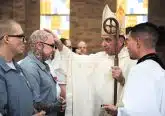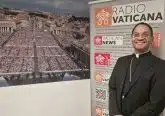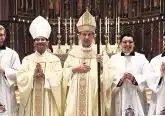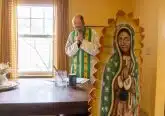Seton Route makes only prison stop on National Eucharistic Pilgrimage
Columbus, Ohio, Jul 7, 2024 / 06:00 am
The four routes of the National Eucharistic Pilgrimage have covered thousands of miles from coast to coast and from the southern border of the United States to the far north, but only one has made a stop at a prison.
On June 28, the Seton Route of the National Eucharistic Pilgrimage visited Pickaway Correctional Institution in Orient, Ohio, for a Mass and procession at the facility southwest of Columbus.
Bishop Earl Fernandes celebrated the Mass along with Father Roger Landry, the chaplain for the Seton Route of the pilgrimage; Father Joseph Trapp, a diocesan prison chaplain; and Father Justin Alarcon, CFR, a member of the Franciscan Friars of the Renewal religious order who is traveling the entire route with the Perpetual Pilgrims accompanying the Blessed Sacrament from May in Connecticut up through the National Eucharistic Congress that starts July 17 in Indianapolis.
Approximately 35 incarcerated men attended Mass and 25 were able to participate in the procession afterward.
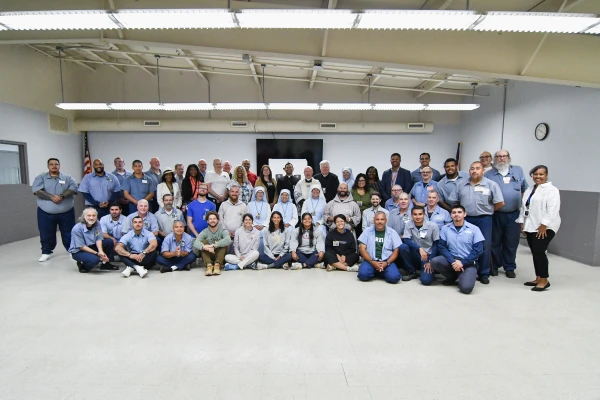
The chance to go inside a prison to bring Christ to the men there proved to be one of the most profound experiences of the 1,100-mile trip for the priests and the pilgrims, who along the way have visited St. Patrick’s Cathedral and the Statue of Liberty in New York and traveled to Baltimore; Washington, D.C.; Philadelphia; and Pittsburgh, among other places.
Later that day, the pilgrims took the Blessed Sacrament to the Mother Angeline McCrory Center on the east side of Columbus for a procession and Holy Hour for the aged and infirm residents there. In the early evening, the pilgrimage moved to Columbus’ St. Charles Preparatory School for a vigil Mass on the solemnity of Ss. Peter and Paul. The night ended with a tour of the Museum of Catholic Art and History in downtown Columbus.

At Pickaway Correctional, the bishop and priests were joined by the six pilgrims, the Sisters of the Daughters of Mary, Mother of Healing Love — who are also making the pilgrimage — and prison staff and representatives from the diocese.
Before a period of Eucharistic adoration, Fernandes and Alarcon heard confessions. The bishop and priests then celebrated Mass, which was followed by a Eucharistic procession that went outside into the yard at the prison.
Fernandes explained to the men in his homily, which he delivered in English and then in Spanish, that they were part of a unique opportunity as the only facility of its kind to experience the National Eucharistic Pilgrimage.
“Why? Because Jesus wants to be close to you,” Fernandes said. “There is nothing in the world that can keep Jesus’ mercy and Jesus’ love from you. Not even the walls of this place.”
“On the evening of the Resurrection, in St. John’s Gospel, the apostles were all locked inside, behind closed doors. They were afraid. And the risen Lord passed through those doors and he said, ‘Peace be with you.’ Jesus wants to bring you his peace, his mercy and love. He wants to bring you that peace which the world cannot give. And, so, in a way, we are grateful for the opportunity to be here, to be with you.”
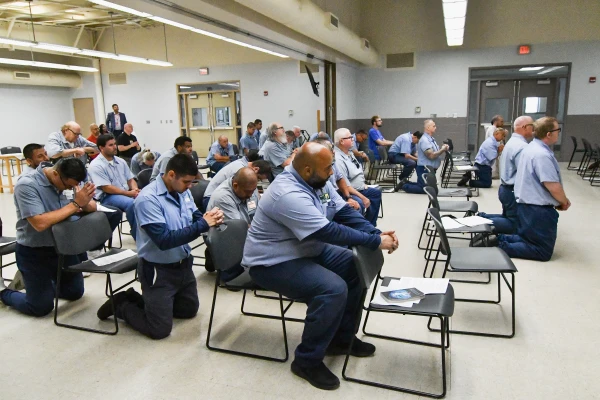
He continued: “Jesus has come here to heal you, to cleanse you, to make you fit for worship, so that you may offer your gift of a humble, contrite heart, the gift of a changed life — a gift that, when changed by the love and mercy of Jesus, enables you to change the lives of others here.”
“Jesus offers that opportunity to all of you who are here on a longer-term basis, to all of us who get to walk around and breathe the fresh air — all of these things Jesus offers for us because he is merciful, because he is kind, and because he loves us,” he said. “But while Jesus offers us his mercy, he offers us something even more precious: his flesh and blood for the life of the world, in the holy Eucharist, in the holy Communion.”
“In the Eucharist, God is close. He is close to his people and he wants to be with you, here in the Diocese of Columbus and here in Pickaway Correctional.”
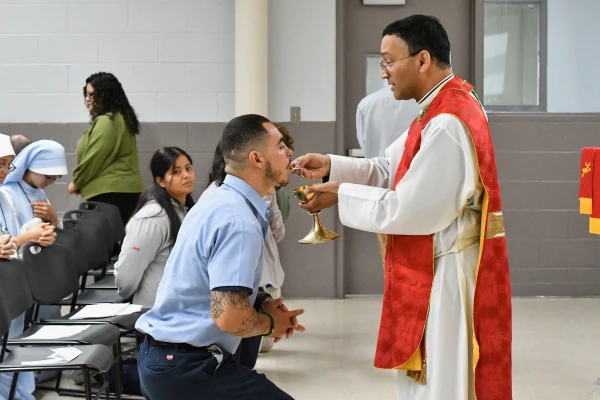
After the Eucharistic procession, the priests and pilgrims spent time talking with the men and getting to know their stories.
“When we went to the prison, wherever you go, finding people that love the Lord so much and so deeply shows that the love of Christ can get through any wall and gate,” said Dominic Carstens, one of the Perpetual Pilgrims, after the prison visit. “He will go to you when you’re 95 years old living in a nursing home or when you’re incarcerated.”
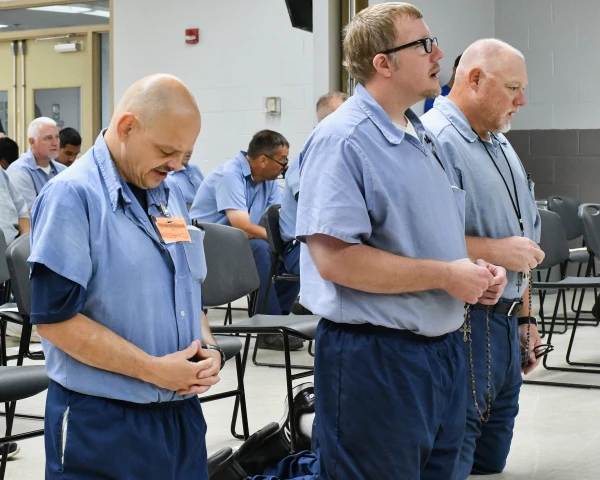
Brian Thoma, who has served nearly nine years of a 28-year prison sentence, celebrated his 50th birthday on the day of the pilgrimage.
“For this [the visit by the National Eucharistic Pilgrimage] to happen, it’s special,” he said. “It helps us realize that there are people out there who do care about us, they haven’t forgotten about us. It’s uplifting. It’s good for the spirit.”
Thoma, a cradle Catholic who said he was an altar server and attended Catholic grade and middle school, attends Mass in the prison chapel on a regular basis and adoration on the first Saturday of every month.
“Having Jesus present on this day is a real gift,” Thoma said. “The first thing I did after being incarcerated at CRC [Correctional Reception Center of the Ohio Department of Rehabilitation and Correction] was to find a Catholic chaplain. And I got into confession and started going to Mass regularly there. And when I got transferred here [Pickaway Correctional Institution], same thing.”
“It’s helped me out. It’s something that keeps me grounded, staying in the faith,” he said. “I know that Jesus loves me. If anything, you’ve got to keep the faith, and that’s what I’ve been trying to do. It helps me. Helps me along. Helps my day to day.”
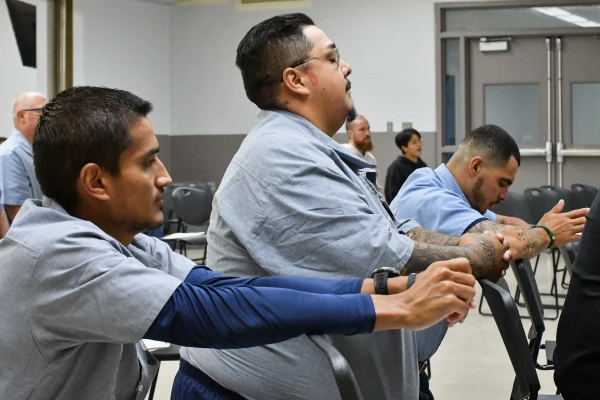
Josue Puga spent time visiting with the pilgrims and explained that he grew up Catholic and was raised in the faith by his parents. He said he attends Mass regularly in the chapel.
“[Faith] gives me peace and keeps me going day by day and helps me feel the Holy Spirit in my life,” he said. “I know Jesus will always be by my side and guide me in the right way.”
This article was originally published by The Catholic Times and is reprinted here with permission.










